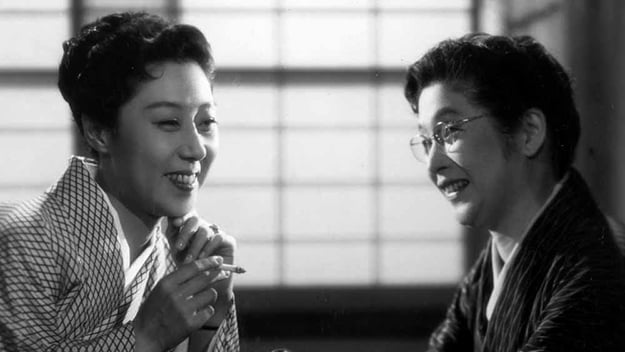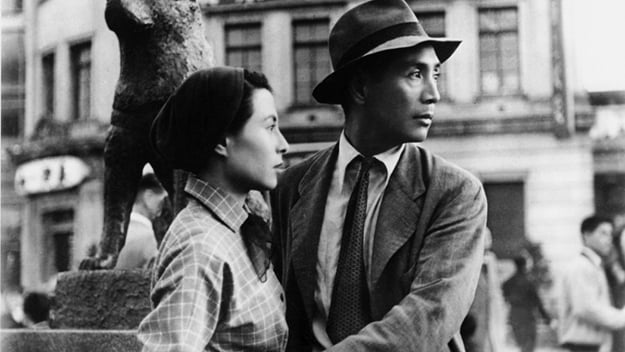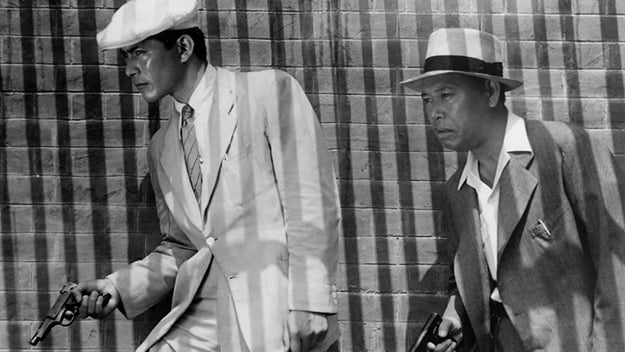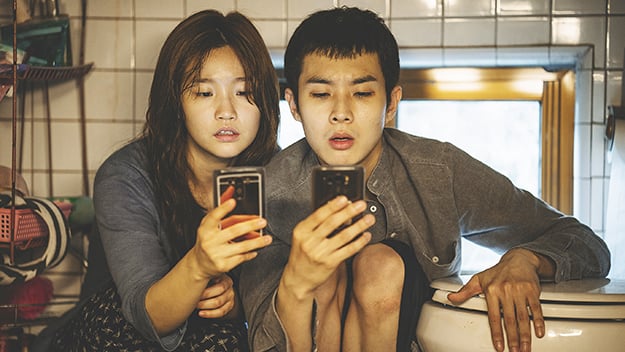Phantom Light: “Shitamachi: Tales of Downtown Tokyo” and Parasite

Flowing (Mikio Naruse, 1956)
In the West, Japanese cinema is best known for period epics, serene family dramas, and popular genres revolving around samurai, yakuza, and ghosts. But Japan also has a great homegrown tradition of neorealism: from Yasujiro Ozu’s silent masterpiece An Inn in Tokyo (1935) to Hirokazu Kore-eda’s Shoplifters (2018), films have turned a warmly compassionate but unsparing eye on the lives of the working classes and the marginalized, amid the shot-on-location grit of polluted canals, scrubby wetlands, dirt-road suburbs, tenements, and neon-lit back-alleys. Film Forum celebrates this lineage with the series “Shitamachi: Tales of Downtown Tokyo,” curated by Aiko Masubuchi. Often translated as “downtown,” shitamachi literally means “low town” and refers not only to low-lying neighborhoods of Tokyo inhabited by workers, but to the culture associated with these areas reaching back to popular art forms like kabuki theater and woodblock prints depicting the raffish “floating world” of geisha, prostitutes, actors, and urban merchants. The films in the series illustrate the breadth of this tradition, ranging from raucous comedies to bleak tragedies, from crime thrillers to domestic melodrama, from familiar masterworks (Ozu’s Tokyo Story, Kenji Mizoguchi’s Street of Shame, Akira Kurosawa’s Ikiru) to the rare and obscure, with many prints imported from Japan and newly subtitled for the series.
While some of these movies are explicit in their outrage at social injustice,, others are radical in their commitment to honoring the ordinary. There are three titles in the lineup by director Mikio Naruse, who combines a meticulous texture of everyday life with a refusal of conventional dramatic plots. Naruse quietly observes the quotidian battles of working women to hold things together without husbands, marking both the constant indignities women are subjected to, and the way they are worn down by them yet continue to endure. Kinuyo Tanaka appears in all three films, playing a head bar hostess in Ginza Cosmetics (1951), the owner of a laundry in the tender family portrait Mother (1952), and a maid in a struggling geisha house in the elegiac Flowing (1956). In Ginza Cosmetics, she spends her days doing housework and her nights politely listening to the caterwauling of drunks. Her face reveals all the dispiriting effort of the dutiful, brightly appeasing smiles it usually wears, as she chases deadbeats and fends off the pawing and propositions of businessmen, while the son for whose sake she is doing all this runs unsupervised in the bustling streets. The need for money is a constant refrain, present in every scene like the dripping of a leaky tap. Life for almost everyone is reduced to a petty struggle for cash, so when Tanaka meets a young man who recites poetry and shows her the constellations—instead of the neon bar signs of the Ginza—she is momentarily exhilarated by the glimpse of something more. But, as Naruse said of his characters, “If they move even a little, they quickly hit the wall.”
After starring in films by Naruse, Ozu, and Mizoguchi, Tanaka became a director herself, an audacious step for a woman at the time. In her debut, Love Letter (1953), she takes on a particularly sensitive subject: the humiliation of Japanese men in the wake of World War II, particularly in the face of the many Japanese women who slept with American GI’s to pay the bills. The movie opens with the elegant Masayuki Mori (who starred with Tanaka the same year in Mizoguchi’s Ugetsu) hanging up laundry in a cramped little flat. Five years after the war, he is barely employed, living with his go-getter brother, and paralyzed by passivity, haunting train stations and crowded street corners in hopes of finding a woman he loved and lost. One day he runs into a friend who offers him a job, helping out with a business writing letters in English for women contacting their American boyfriends. The “love letters” of the title are pleas for money in the guise of flowery epistles of passion. Though he despises these women, Reikichi (Mori) is glad of something to do, until one day he recognizes the voice of a client, Michiko (Yoshiko Kuga)—the woman he has been searching for.

Love Letter (Kinuyo Tanaka, 1953)
In one of the film’s most finely staged scenes, the two finally come face to face on a station platform: hearing him call her, she steps off the train and fights her way the dense crowd; the camera stays in the carriage as the door slides closed, framing their reunion in the window, and then glides away with the train—into a flashback to their idyllic childhood together. Shattered by the discovery that she has been a GI’s mistress, Reikichi berates and shuns Michiko, stubbornly resisting the arguments of his brother and his friend who urge him to forgive her and understand the scant choices she and other women had. A romantic melodrama, Love Letter is also a hard look at the wreckage of war—not just towns leveled by air raids, but crushed dreams and shame in a defeated country.
Set in the same postwar period, Yasuki Chiba’s Shitamachi (1957) is a small-scale, delicate but piercing drama about two lonely souls who find fleeting happiness together amid hard-scrabble poverty. Isuzu Yamada plays Mrs. Ryo, a woman struggling to support herself and her son as a tea peddler, waiting in vain for her husband to return from the POW camps of Siberia. She meets Tsuru (Toshiro Mifune), a gentle, kind-hearted truck driver who lives in a shack in a junkyard, his wife having taken up with another man while he was in the army. (The same year, these two icons co-starred in Kurosawa’s Throne of Blood—the films, and their characters, could hardly be more different.) The settings have a grunge you can smell: a narrow alley where a garbage-choked gutter runs beneath rotting wooden slats, a river lined with smokestacks and industrial detritus, a weedy wasteland where Ryo and her son choke on the dust from passing trucks and the son stolidly regards a dead cat lying by the side of the road. But in these grim, grimy surroundings, kindness glimmers like wildflowers poking through cracks in the pavement. Mrs. Ryo befriends her next-door neighbor, a young prostitute whose husband is in a sanitarium; over melancholy late-night coffee, she confides that her loneliness is so intense that she feels like she is drowning. The camera retreats slowly out the window and lurks among the dark rooftops and chimney-pots as the two women sit smoking cigarettes and listening to the radio in the wake of a death.
An even more beautiful shot catches the reflections of the main characters as they drift across puddles in the sidewalk, an image of the ephemerality that haunts the film. The scenes when Tsuru and Mrs. Ryo are together, and in which he bonds with her fatherless child, taking him to a shrine festival and an amusement park, have a warmth that is shot through with a palpable sense of being too good to last. At the heart of the film is a scene where the three spend a rainy night at an inn with a flashing neon sign—a place so downscale that it serves only ramen, not soba, and bad ramen at that. Lying on tatami mats in the dark, the man and woman speak intimately of their losses, and despite the presence of the child sleeping between them, their yearning for each other is thick in the air.
Yamada’s performance builds exquisitely, and devastatingly, from reserve to emotional openness. Mifune was never more appealing than he is here, as a handsome, regular guy who—in a world of men who are either absent, craven, or sleazy—seems to offer love and dependability. The actor makes several other appearances in the Film Forum series: as a flashy, feral gangster dying of TB in Drunken Angel (1948), a zealously conscientious rookie cop in Stray Dog (1949), and a scruffy, hot-tempered thief living with a motley crew of low-lifes in a flophouse in The Lower Depths (1957)—all directed by Akira Kurosawa.

Stray Dog (Akira Kurosawa, 1949)
In Stray Dog, Mifune’s straight-arrow police detective Murakami frantically searches the broiling, chaotic streets for his stolen pistol. As he wanders through back alleys and shabby markets filled with sweaty, jostling crowds, he is followed by a restless, jumpy camera dazed by flickering sun and dusty haze. Like the scummy, pestilent pond in Drunken Angel, the heat-struck slums are a visual representation of the nation’s postwar malaise, its mood of exhausted tension and reckless nihilism, of simmering shame and anger that build, at the end of Stray Dog, to a giant howl of despair. The resentful, jobless young man who stole the gun is explicitly presented as Murakami’s double, and the cop is overwhelmed with guilt about his doppelganger’s crimes, as though they were somehow his own. Both men are army veterans, both members of what an older detective calls the “après-guerre” generation.
The uncanny link between a criminal and his victim and the boldly symbolic use of settings return in Kurosawa’s 1963 film High and Low (set in Yokohama rather than Tokyo, it is not in the “Shitamachi” series). The story plunges from the sleekly modern hilltop home of a business executive into the wretched shacks and alleys below. The kidnapper who schemes against the tycoon finally admits that he was goaded by envy of that conspicuous mansion—a confession staged in a prison visiting room, with the two men separated by plexiglass that allows their faces to be superimposed on each other.

Parasite (Bong Joon-ho, 2019)
Bong Joon-ho’s Palme d’Or–winner Parasite uses some of the same techniques to crystallize the horror and the absurdity of economic inequality in South Korea. Following a destitute family as they worm their way into the home and onto the payroll of a wealthy one, the film draws the starkest contrast between the spotless, airy, tranquil estate of the Parks and the dank, cluttered, vermin-infested basement apartment of the Kims. It further elaborates on the subterranean metaphor with a labyrinthine bunker under the Park mansion, haunted by lurking secrets. Staircases abound—the concrete steps down to this cellar, site of gruesome violence and startling emergences, and the endless floating stairs that descend from the elevated neighborhood of the rich to the low-lying, flood-prone slums, as though connecting heaven to hell.
Tonally, the film also makes giant leaps—from very funny, caustic black comedy to blood-drenched terror to a kind of rueful meditativeness in the epilogue. It is a bit late to summon empathy, after the almost gleeful nastiness and comprehensive misanthropy that has come before: here, the rich are nice but stunted and oblivious, and the poor are clever and ruthless but also somehow sloppy and self-sabotaging. But if Parasite lacks humanist warmth, it has an unforgettable hyper-clarity in its anatomy of life at the bottom: from the minor inconvenience of hunting for free wifi to the catastrophe of an erupting toilet, from the necessity of humbling oneself to a displeased boss to the desperation that might justify murder. Mr. Kim seems able to absorb all the deprivations of his life with equanimity, but not the knowledge that his boss thinks he smells bad—“like an old radish”—a small humiliation that drives him over the edge.
The doppelganger motif—multiplied here as in a hall of mirrors—is a potent way to reveal the hidden connections and dependencies and clandestine intimacies between the classes. Parasite draws out the uncomfortable complexities of these relationships, of how the poor view the rich (with a mixture of covetous envy, resentment, and awe-struck respect) and the rich view the poor (with condescension tinged by both revulsion and titillation). Seemingly worlds apart, they are, literally, right on top of each other.
Imogen Sara Smith is the author of In Lonely Places: Film Noir Beyond the City and Buster Keaton: The Persistence of Comedy, and has written for The Criterion Collection and elsewhere. Phantom Light is her regular column for Film Comment.




